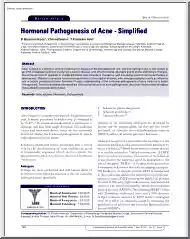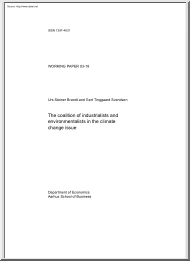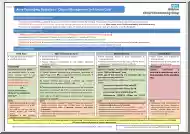Nincs még értékelés. Legyél Te az első!
Mit olvastak a többiek, ha ezzel végeztek?
Tartalmi kivonat
Hormonal acne Also known as Adult Acne, female acne, post-adolescent acne, late onset acne What is adult acne? Adult acne is acne that continues past the ages of 18 to 20 or starts in the early 20s in individuals who may not have had a previous problem with acne. It can occur in men but is more frequently seen in women. Acne Vulgaris on the other hand typically affects adolescents What causes adult acne? Many factors interact to cause acne. These include: An increase in oil (sebum) Increased numbers of acne bacteria (Propionibacterium acnes) in the oil glands Blockage of the pilosebaceous duct because of increased skin cells and inflammation. It is unclear whether increased levels of male hormone (androgens) in the blood from the adrenal glands or ovaries or tiny amounts of locally produced male hormones stimulate the oil gland to produce more oil or sebum, leading to adult acne. What does adult acne look like? Adult acne has a similar appearance to acne vulgaris with
whiteheads, blackheads, pustules, papules, nodules or cysts occurring on the face and less frequently on the back and chest. The post- inflammatory healing phase with redness or brown hyperpigmentation is also seen. Many women affected with adult acne experience a flare-up of their acne the week prior to their menstrual cycle. Acne lesions are often tender, long lasting and may recur in the same areas. The lower cheeks, jawline and neck are often affected but pimples and blackheads may be seen in all the areas that are involved in adolescent acne. What other problems can occur with adult acne? Most women with adult acne do not have increased male hormone as the main reason for their acne. However, your dermatologist will evaluate whether there is clinical evidence of increased hair growth, male pattern scalp hair loss, irregular menstruation, problems with infertility or signs of insulin resistance. Some medications may precipitate or aggravate acne. How is adult acne diagnosed? A
medical history and physical examination will guide any further blood or imaging investigations that may be needed to evaluate suspected hormonal abnormalities or signs of insulin resistance. In some cases, an ultrasound may be needed to look for polycystic ovaries. How is adult acne treated? Treatment is the same as for acne vulgaris. Often a combination therapy with both topical and oral agents is used. Avoiding heavy cosmetics is advised Hormonal treatments with oral contraceptive or hormone blocking agents such as spironolactone or cyproterone actetate that reduce the effect of androgens are often prescribed. For treatment resistant cases, long-term low dose oral isotretinoin has been used by specialist dermatologists. What is the likely outcome of adult acne? Adult a e ay start i the 20s a d o e ofte des ri e ha i g good ski at s hool. It ay also e persistent from adolescence. This type of acne may fluctuate with stress or the menstrual cycle. It may remain active for many
years into the 30s and 40s
whiteheads, blackheads, pustules, papules, nodules or cysts occurring on the face and less frequently on the back and chest. The post- inflammatory healing phase with redness or brown hyperpigmentation is also seen. Many women affected with adult acne experience a flare-up of their acne the week prior to their menstrual cycle. Acne lesions are often tender, long lasting and may recur in the same areas. The lower cheeks, jawline and neck are often affected but pimples and blackheads may be seen in all the areas that are involved in adolescent acne. What other problems can occur with adult acne? Most women with adult acne do not have increased male hormone as the main reason for their acne. However, your dermatologist will evaluate whether there is clinical evidence of increased hair growth, male pattern scalp hair loss, irregular menstruation, problems with infertility or signs of insulin resistance. Some medications may precipitate or aggravate acne. How is adult acne diagnosed? A
medical history and physical examination will guide any further blood or imaging investigations that may be needed to evaluate suspected hormonal abnormalities or signs of insulin resistance. In some cases, an ultrasound may be needed to look for polycystic ovaries. How is adult acne treated? Treatment is the same as for acne vulgaris. Often a combination therapy with both topical and oral agents is used. Avoiding heavy cosmetics is advised Hormonal treatments with oral contraceptive or hormone blocking agents such as spironolactone or cyproterone actetate that reduce the effect of androgens are often prescribed. For treatment resistant cases, long-term low dose oral isotretinoin has been used by specialist dermatologists. What is the likely outcome of adult acne? Adult a e ay start i the 20s a d o e ofte des ri e ha i g good ski at s hool. It ay also e persistent from adolescence. This type of acne may fluctuate with stress or the menstrual cycle. It may remain active for many
years into the 30s and 40s




